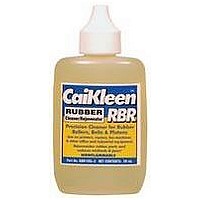RBR100L-2 CAIG LABORATORIES, RBR100L-2 Datasheet - Page 2

RBR100L-2
Manufacturer Part Number
RBR100L-2
Description
RUBBER CLEANER, BOTTLE, 59ML
Manufacturer
CAIG LABORATORIES
Series
CaiKleen RBRr
Datasheet
1.RBR100L-2.pdf
(7 pages)
Specifications of RBR100L-2
Cleaner Applications
Office Equipment, Machinery, Rubber Rollers & Platens
Dispensing Method
Bottle
Volume
59ml
Lead Free Status / RoHS Status
Lead free / RoHS Compliant
MINERAL SEAL OIL
CHLORINATED FATTY ESTER
d-LIMONENE
Prepared to OSHA, ACC, ANSI, WHMIS & 2001/58 EC Standards
4.1
4.2
5.1
5.2
5.3
5.4
5.5
5.6
CHEMICAL NAME(S)
First Aid:
EYES:
SKIN:
INGESTION:
INHALATION:
Medical Conditions Aggravated by Exposure:
Personnel with pre-existing skin disorders should avoid repeated or prolonged contact
with this product.
Flashpoint & Method:
> 200 °F, Cleveland Open Cup (based on mineral seal oil)
Autoignition Temperature:
NA
Flammability Limits:
Fire & Explosion Hazards:
This material can burn but will not readily ignite. This material will release vapors when heated above
the flash point temperature that can ignite when exposed to a source of ignition. In enclosed spaces,
heated vapor can ignite with explosive force. Mists or sprays may burn at temperatures below the flash
point. Carbon dioxide, carbon monoxide, smoke, fumes, unburned hydrocarbons and trace oxides of
sulfur, phosphorus, zinc and nitrogen. Also, depending upon the conditions of use, low concentrations of
hydrogen sulfide can be released.
Extinguishing Methods:
Dry chemical, foam, carbon dioxide and water fog.
Firefighting Procedures:
Keep containers cool until well after the fire is out. Use water spray to cool fire-exposed surfaces and to
protect personal. Avoid spraying water directly into storage containers because of danger of boilover.
Prevent runoff from fire control or dilution from entering sewers, drains, drinking water supply, or any
natural waterway. Firefighters must use full bunker gear including NIOSH-approved positive pressure
self-contained
decomposition products and oxygen deficiencies.
breathing
As a precaution remove contact lenses if worn and flush eyes thoroughly with copious amounts of water for at least
15 minutes, holding eyelid(s) open to ensure complete flushing.
attention.
Remove contaminated clothing. Use a waterless hand cleaner, mineral oil, or petroleum jelly to remove the material.
Then wash the skin with soap and water If irritation persists, seek prompt medical attention.
contaminated clothing until after it has been properly cleaned.
Do not induce vomiting unless directed to by a physician. Do not give anything to drink unless directed to by a
physician. Never give anything by mouth to a person who is not fully conscious. Seek medical attention immediately.
Vapor inhalation under ambient conditions is normally not a problem.
immediately remove victim to fresh air at once. If breathing is difficult, administer supplemental oxygen and seek
immediate medical attention. If breathing stops, perform artificial respiration.
68440-29-9
64742-30-9
5989-27-5
MATERIAL SAFETY DATA SHEET
apparatus
CAS No.
3. COMPOSITION & INGREDIENT INFORMATION
PY8030000
NA
GW6360000
to
Lower Explosive Limit (LEL):
RTECS No.
5. FIREFIGHTING MEASURES
protect
4. FIRST AID MEASURES
235-183-3
270-448-1
227-813-5
against
EINECS No.
potential
≤ 90.0
≤ 15.0
≤ 5.0
MSDS Revision: 1.0
%
hazardous
NA
ACGIH - ppm
TLV
NA
NA
5
combustion
STEL
NA
NA
If irritation persists, seek immediate medical
10
HEALTH
FLAMMABILITY
REACTIVITY
PROTECTIVE EQUIPMENT
EYES
Upper Explosive Limit (UEL):
EXPOSURE LIMITS IN AIR (mg/m
If overcome by vapor of hot product
MSDS Revision Date: 01/01/2007
PEL
NA
NA
5
SKIN
or
OSHA - ppm
STEL
NA
AN
3
Page 2 of 7
MSDS-E-RBR100L
IDLH
NA
NA
NA
3
Do not wear
)
NA
OTHER
MIST
1
1
0
B






